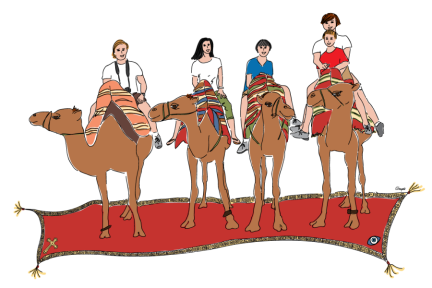The infamous bank robber, Jesse James, is part of American history. His life has been chronicled in movies, documentaries and stories. In Clay, Missouri, approximately 22 miles from downtown Kansas City, is the birthplace museum of this controversial figure. More specifically, this birthplace museum is in Kearney, Mo.
While touring another destination in Kansas City, we happened upon some tourism information at a tourism desk. Where there used to be numerous travel guide brochures, things have gone “touchless” due to Covid-19. We might not have noticed the information on Jesse James Birthplace/Museum if it hadn’t been for that screen. Quickly, I recorded the information on my phone and found the website in order to plan our excursion there.
Luckily, despite it being a holiday weekend (NY Eve), a snowfall and the Covid-19 restrictions everywhere, the museum and grounds were open! Our car traversed the risky roads which fortunately had not iced over. I carefully trudged through the thick, deep snow across the grounds. Nervously, I walked heavy-footed so I wouldn’t slip or damage my camera. Rather than going on the shoveled walkway, I walked in the nearby snow. This exploration break was fortuitous because I absorbed the natural beauty of this wilderness location blanketed by PERFECT snowfall. It was the kind of snow that insulates. It shut out noise and literally nestled the grounds into a womb-like snow globe effect.
I peeked into the windows of the home and saw authentic period furniture but the doors were locked and not part of the tour. I made a mental note to come back and view everything with my husband after our museum tour. We walked through the museum and watched a fascinating 20 minute movie. Below are my photos of the grounds and nearby roads.
We walked out to the grounds again to experience everything up close. There was a gravesite and monument next to the rough-hewn, log cabin exposure. My husband pointed out to me a stork migration overhead in the January sky. I have never seen a flock of storks. They mimicked the spiky, bare tree branches within my viewfinder. I walked out into the field to enjoy the picturesque fences, groups of trees, leading lines of the curved trail with tufts of snow bordering the paths. It was SURREAL. Seeing the grounds like THIS made me realize what it must’ve been like for the residents to live out in remote wilderness or even small towns during the winter. Security, trust, fear, risky, spontaneity were all words that flashed through my mind as I envisioned the people rocking in their chairs by the fire as their days subsumed into darkest night. Life must’ve seemed so temporary all of the time, yet, some of Jesse’s relatives lived well into their nineties!
I walked out into the field to enjoy the picturesque fences, groups of trees, leading lines of the curved trail with tufts of snow bordering the paths. It was SURREAL. Seeing the grounds like THIS made me realize what it must’ve been like for the residents to live out in remote wilderness or even small towns during the winter. Security, trust, fear, risky, spontaneity were all words that flashed through my mind as I envisioned the people rocking in their chairs by the fire as their days subsumed into darkest night. Life must’ve seemed so temporary all of the time, yet, some of Jesse’s relatives lived well into their nineties!
JESSE JAMES HISTORY (cited from the museum movie)
Here’s what we learned about the Jesse James family. Jesse’s mother, Zereleda, gave birth to him in 1847. His father preached in California during the Gold Rush. When Preacher James died, the children became heirs of the estate under the care of their uncle. Their own mother did not have rights to the estate. She remarried but her new husband, Benjamin Simms, rejected the children. When she later re-married, she had a prenup which ensured that she inherit six slaves and some land. (The slaves’ cabin was on the grounds we toured.) War erupted and the James family sided with the South. Home Guards were formed which were a form of a militia group. In 1861, Jesse’s brother Frank and his unit engaged in the Civil War. Jesse was only sixteen years old. Frank rode with Quantrill’s guerrillas while Jesse rode with Bloody Bill Anderson. The Bushwhackers hung Dr. Samuel (Jesse’s stepfather.) Zerelda the mother who was pregnant at the time was assaulted, too. Zerelda, Reuben and the children abandoned their home and settled in exile in Nebraska. At one point when Jesse was shot in the lung and injured, he convalesced in his mother’s home.
Jesse helped plan the heist of the downtown Liberty, Mo. Jesse actually published a letter in the newspaper claiming his innocence. In 1875, the James Farm tragedy happened due to the Pinkerton Raid. It was believed that a fireball was thrown into the home. Zerelda reportedly witnessed her child’s death. Jesse eventually formed a new gang and the Governor offered reward money for Jesse’s capture. In 1882, Bob Ford shot Jesse James in St. Joseph, Mo. Thousands trekked to Kearney to view Jesse’s body.
Departing the grounds, we found the Woolen Mill and Mt. Gilead one room schoolhouse venues and decided to save those for another visit since the roads were risky and the facilities did not look open for tourists. Scroll through the photos in the link below.
https://jessejamesmuseum.org/plan-your-visit/area-attractions/
photos by Gina Kingsley
